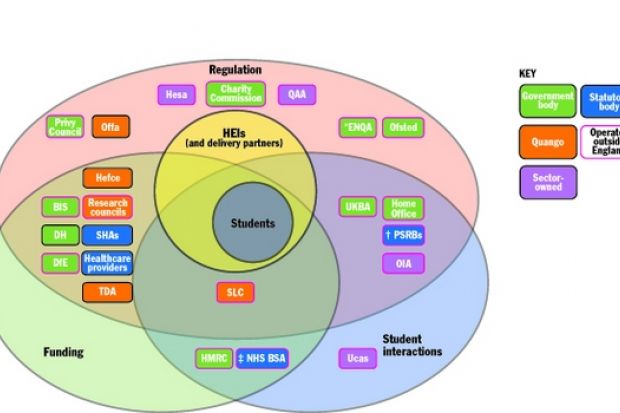The switch to a new funding regime and delays to the government's higher education bill have created a part-changed regulatory system that contains "a risk of instability" and "may not be fully equipped to function", according to a report by England's funding council.
The Interim Regulatory Partnership Group (IRPG) was established by the Higher Education Funding Council for England and the Student Loans Company to advise the government, Hefce and other agencies on issues arising from the development of the reformed funding and regulatory regime.
The IRPG's first project, Mapping the Higher Education Funding and Regulatory System in England, written by a team from Hefce and Deloitte, delivers a warning in the conclusion of its summary report.
It notes that "the dramatic changes to the funding landscape in academic year 2012-13, coupled with uncertainty about the HE bill, have left the system in a partially changed state ... The project's conclusion is that the system as it stands may not be fully equipped to function and that there is a risk of instability if existing gaps in the system are not filled."
No bill, no bite
The delay in turning the government's higher education White Paper into a bill has created a number of regulatory issues.
The White Paper, published last summer, contained plans to give Hefce a far stronger regulatory position as a "consumer champion" - but as yet there is no prospect of legislation to establish the role.
Under the old system, Hefce attached terms and conditions to grants through its financial memoranda with institutions, giving it the power to withdraw grants.
But as grant is replaced by SLC funding, Hefce's ability to withdraw money as a sanction on behalf of the Office for Fair Access "will hold less weight", the report says. It also notes: "The SLC is not a regulator and there is currently no clear accountability for teaching funding that is distributed via tuition loans."
The White Paper contained plans to create a "level playing field" between universities and private providers, bringing the latter under Hefce's beefed-up powers.
The IRPG report notes the "uneven regulation of private providers" in the absence of the required legislation.
Some private providers are "outside the remit of review by (the Quality Assurance Agency)", it notes.
"In addition, private providers are not subject to student number control, which means that the (Department for Business, Innovation and Skills') budget for tuition loans is not controlled in this area."
The report also contains a graphic illustrating the sector's "complex and potentially confusing" regulatory system (see below).
According to the document, the IRPG should "urgently engage with BIS to agree how the system can be reformed, with or without legislation; and also agree a second phase of the project which will make recommendations for a new funding and regulatory system in the short to medium term".
The report was published on 4 May, the week before the Queen's Speech unveiling the government's legislative programme for the 2012-13 session of Parliament.
As expected, the speech contained no reference to a higher education bill.
